Davim J.P.Machining of Hard Materials
Подождите немного. Документ загружается.

5 Finite-element Modeling and Simulation 147
The Eulerian description considers a fixed region in the geometric space occu-
pied by continuum material examined over time. The space domain is discretized
and the movement must be determined with a mesh that stays fixed at every mo-
ment. That is, the nodes do not move during the analysis and they are not fixed to
the material [9, 35, 36, 50–52]. This approach is very fast to execute, but great
difficulties appear when dealing with the free-surface treatment. Indeed, as in the
beginning of the simulation the chip shape is not known, adaptation algorithms of
the mesh will be needed.
As in the case of the Lagrangian formulation, to predict the serrated chip for-
mation, a crack propagation criterion is needed. On the other hand, this Eulerian
approach is used solely in the steady-state analysis.
Finally, another method of description of the movement is the ALE or mixed
description [46, 53–58]. In this formulation, the nodes can move, but always re-
main inside the boundary region defined in the ALE domain. The major advan-
tages are: easy application of the boundary conditions, easy treatment of the inter-
faces and lower distortion of the mesh, etc.
5.2.1 Commercial Software
The two major commercial software programs existing on the market are Advant-
Edge and DEFORM-2D/-3D. Both programs provide an interface to the end user,
in order to ease the introduction of process parameters and in a way make trans-
parent those subjects dealing with the mathematical theory of the finite-element
method.
DEFORM is software specialized for modeling machining operations in 2D and
3D based on an implicit integration method, with fully coupled thermo-mechanical
analysis. Since the formulation is Lagrangian, an adaptive remeshing technique is
used to reduce the mesh distortions when the chip is formed.
Several material constitutive laws can be used to model the material behavior
(Oxley’s equation, Johnson–Cook equation, among others). A material database
can be found in this software, both for tool and workpiece materials. For modeling
the contact at the tool–chip interface, a constant shear factor friction law or Cou-
lomb friction law can be employed.
Workpiece and tool geometries should be configured by the user, both in terms
of the external dimensions and those of the mesh of the two parts. However, coat-
ing layers can be implemented in the tool. Also remarkable is the availability of
loading some existing geometries of tools and toolholders from a database incor-
porated in the program.
AdvantEdge is an explicit dynamic, fully thermo-mechanically coupled finite-
element program specialized in modeling machining operations in 2D and 3D.
Lagrangian techniques are employed for modeling the metal-cutting process.
Tracking discrete material points and using a predetermined line of separation to
148 P.J. Arrazola
generate a fictitious crack, is possible to obtain the chip and the workpiece. As the
formulation is Lagrangian, an adaptive remeshing technique is used to reduce the
mesh distortions.
The material constitutive law employed is the Marusich–Ortiz law [44]. Other
material models can be implemented through the use of subroutines. As in
DEFORM, a material database can be found in this software, both for tool and
workpiece materials. For modeling the contact at the tool–chip interface the Cou-
lomb friction law is employed.
Specific process characteristics can be defined like the use of coolant and its
properties, the friction coefficient at the contact or the option to predict burrs in
the workpiece.
5.2.2 State of the Art in Finite-element Models of Hard Turning
In order to reduce the experimental costs, FEM of hard turning can be employed to
qualitatively predict tool forces, stress, temperature, strain and strain rate fields.
Having this in mind, with the existing difficulties to identify input parameters
properly it is not possible to obtain reliable quantitative values. It also allows the
estimation of the superficial state of the machined surface, that is, the residual
stresses induced in the workpiece. A finite-element model for 3D turning has also
been introduced in earlier studies. Guo and Liu [59] proposed 3D FEM for hard
turning of AISI 52100 steel using PCBN tools. The model was used to predict the
cutting forces, temperature distribution over the cutting edge, and the residual-
stress distribution on the machined surface. Effects of edge preparation in cutting
tools for hard turning have been studied using FEM simulations by Yen et al. [60]
and Chen et al. [59]. Klocke and Kratz [18] used 3D FEM to calculate the tem-
perature on a chamfered-edge PCBN tool design. Aurich and Bil [62] proposed
a 3D finite-element model for predicting serrated chip formation when machining
Inconel 718. Özel et al. [18] proposed a 3D model to study the influence of PCBN
tool microgeometry. Arrazola and Özel [54] proposed a 3D finite-element model
for predicting residual stresses developed with Abaqus/Explicit™. Attanasio et al.
[25] proposed a 3D finite-element model for prediction of tool wear in metal-
cutting operations when turning AISI 1045 steel using uncoated tungsten carbide
tools. Kountanya et al. analyzed experimentally and with finite-element simula-
tions the influence of cutting conditions and tool edge geometry when machining
AISI-E52100 steel (in 2D) [63]. Umbrello and Filice [64] proposed a 2D model
employing a hardness-based flow stress and an empirical model for describing the
white- and dark-layer formation. They also proposed the development of hardness-
based flow stress and fracture models for machining AISI H13 tool steel, which
could be applied for a wide range of work material hardness [63].
It is worthwhile mentioning that during recent years, several other research
works have been developed in 3D [8, 19, 24, 25, 66] showing the remarkable
future possibilities of FEM of chip formation processes.

5 Finite-element Modeling and Simulation 149
5.3 Finite-element Modeling of Hard Turning
In order to show qualitatively the possibilities of FEM applied to hard turning, in
the following paragraphs some simulations will be carried out in 2D and 3D using
the commercial software AdvantEdge and DEFORM-2D, and the general-purpose
finite-element analysis software Abaqus/Explicit (v6.6-1). Results about forces,
temperatures, stresses, pressures, and residual stresses (only in 3D analysis) will
be provided and compared qualitatively to experimental results found in the lit-
erature.
5.3.1 Two-dimensional Finite-element Analysis of Hard Turning
Two 2D finite-element models have been employed to study the influence of cut-
ting parameters (cutting speed, feed rate, and cutting-edge finishing) in hard turn-
ing: AdvantEdge and general-purpose FEM software Abaqus/Explicit (v6.6-1).
Information about the model developed with Abaqus/Explicit is presented in
Table 5.1. Data about AdvantEdge correspond to the closest to Abaqus/Explicit
found in the software database.
Twelve simulations were carried out with AdvantEdge, varying the cutting
speed (v) from 100 to 140
m/min, and the feed rate (f) from 0.1
mm/rev to
0.15
mm/rev. Two types of cutting-edge finishing have been employed: (1) a cut-
ting-edge radius of 25
μm and (2) a chamfer of 20°
×
0.1
mm. The whole experi-
mental plan and results are shown in Table 5.2.
The material employed in these calculations is defined by the program database
(AISI 52100), and its law cannot be modified by the user. Only material hardness
can be modified in AdvantEdge and it has been set to 62 HRC.
In the case of Abaqus/Explicit only one simulation has been carried out,
aiming to have a reference point for comparison with AdvantEdge results. Al-
though the limitations have been reported in the literature [67] the thermo-
visco-plastic behavior of the workpiece is modeled by the constitutive Johnson-
Cook equation [68]:
()
()
()
0
0
0
1ln/ 1
−
−
⎡
⎤
⎡⎤
⎡⎤
=+−
+
⎣⎦
⎣⎦
⎢
⎥
⎣
⎦
W
m
m
n
C
AB
θθ
θθ
σεε
ε
(5.1)
where
ε
is the plastic strain,
ε
is the plastic strain rate,
0
ε
is the reference plas-
tic strain rate (0.001
s
–1
),
w
θ
is the temperature of the workpiece,
m
θ
is the melt-
ing temperature of the workpiece material, and
0
θ
(293 K) is the room tempera-
ture. Material constant A is the yield strength, B is the hardening modulus, C is the
strain rate sensitivity, n is the strain-hardening exponent, and m the thermal soften-
ing exponent. Although a more realistic simulation model for the machining proc-
ess should also take into account the state of the work material due to a previous

150 P.J. Arrazola
machining pass or manufacturing process, in our model the material enters the
workpiece without any strain or stress history.
The Coulomb friction law has been employed for the modeling of the tool–chip
interface contact. Heat transfer is allowed on the tool–chip contact area.
The elements employed are CPE4RT, temperature calculation, and hourglass
control.
Table 5.1 Material properties and cutting conditions for the process simulations (Abaqus/Ex-
plicit and DEFORM-3D)
Abaqus/Explicit,
DEFORM-3D
A (MPa) 2482.4
B (MPa) 1498.5
n 0.19
C 0.027
Plasticity,
Johnson–Cook law
m 0.66
Inelastic heat fraction (β) 0.9
Density (ρ)
(kg m
–3
)
Workpiece
(AISI 52100 62HRC)
Tool (PCBN)
7827
3120
Elasticity (E)
(GPa)
Workpiece
Tool
201.33 f
(T)
680
Conductivity (k)
(W m
–1
K
–1
)
Workpiece
Tool
43
100
Specific heat
(c) (J kg
–1
K
–1
)
Workpiece
Tool
458
960
Material
properties
Expansion (K
–1
)
Workpiece
Tool
11.5
×
10
–6
f
(T)
4.9
×
10
–6
Thermal conductance (K
i
) (W m
–2
K
–1
) 1
×
10
8
Heat partition coefficient (Г) 0.5
Friction coefficient (µ) 0.35 (Guo)
Contact
Friction energy transformed into heat (η) 1
Cutting speed (v) (m/min) 100/120/140
Feed rate (f) (mm/rev) 0.1/0.15
Cutting-edge microgeometry Chamfer 20°
×
0.1
mm
Rake angle (γ) (°) –5
Process
Clearance angle (α) (°) 5

5 Finite-element Modeling and Simulation 151
Table 5.2 Experimental plan and results obtained for Abaqus/Explicit and AdvantEdge
Cutting
Forces
Tool Workpiece Chip Shear
plane
stress
Abaqus/Explicit,
AdvantEdge
F
c
(N)
F
f
(N)
Temp
(K)
Temp
(K)
ε σ
(GPa)
Temp
(K)
ε σ
(GPa)
(GPa)
Vc_100_Av_010_r25 63 50 943 769 3 0.5 957 18.4 0.11 3.6
Vc_120_Av_010_r25 58 49 987 793 3 0.66 991 16.6 0.12 3.03
Vc_140_Av_010_r25 56 47 1013 768 2.8 0.82 1015 16.4 0.132 3.3
Vc_100_Av_015_r25 86 55 958 843 4.1 0.45 979 22 0.08 3.1
Vc_120_Av_015_r25 82 52 1106 902 6.1 0.3 1111 26 0.1 3.2
Vc_140_Av_015_r25 80 53 1080 853 4.1 0.72 1087 27 0.068 3.1
Vc_100_Av_010_ch 72 54 1065 878 4 0.3 1077 18.8 0.07 2.6
Vc_120_Av_010_ch 69 54 1079 978 4 0.1 1083 19 0.12 2.1
Vc_140_Av_010_ch 68 55 1093 983 5 0.12 1094 18 0.2 2.8
Vc_100_Av_015_ch 95 69 1136 973 10 0.17 1138 26 0.158 3.4
Vc_120_Av_015_ch 94 68 1143 1123 9.5 0.28 1081 18 0.151 2.9
Vc_140_Av_015_ch 94 80 1178 1043 10 0.2 1179 30 0.06 2.5
Vc_100_Av_010_r25
(Abaqus)
90 60 1350 1150 8 1 1400 35 1.5 3.9
Figure 5.1 shows the zones where the variable results are extracted. As can be
seen, the data about chips is extracted at the secondary shear zone, where the
highest temperature and plastic strains occur. In the case of the workpiece, the
tertiary zone has been selected for extracting data.
The element size employed in the AdvantEdge model is around 5
μm, the same
as the Abaqus model. The minimum and maximum element sizes vary signifi-
cantly, especially in the AdvantEdge model. The maximum value obtained in
AdvantEdge is 75
μm, while in Abaqus the biggest elements are about 30
μm.
Figure 5.1 Results extraction zones
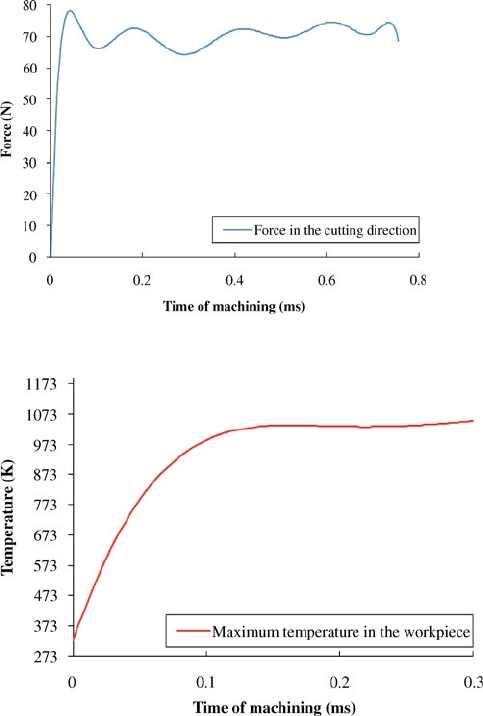
152 P.J. Arrazola
5.3.2 Two-dimensional Finite-element Analysis
of Hard Turning: Results and Discussion
Simulations were run until the steady state was reached, in the case of Abaqus/Ex-
plicit at 1.6
ms, and 0.75
ms in the case of AdvantEdge. In the case of Abaqus,
a previous stabilization process was carried out in order to reach the required cut-
ting speed, in this case 100
m min
–1
. As a consequence of this procedure, from the
1.6
ms stated before only 1
ms is carried out at the specified cutting speed, while
the rest of the time cutting is at lower speeds.
As seen in Figure 5.2 (AdvantEdge), cutting force seems to stabilize around 70
N,
while temperature (Figure 5.3, AdvantEdge) stabilizes at 1000
K after approxi-
mately 0.17
ms.
Figure 5.2 Cutting force in AdvantEdge
Figure 5.3 Workpiece maximum temperature in AdvantEdge
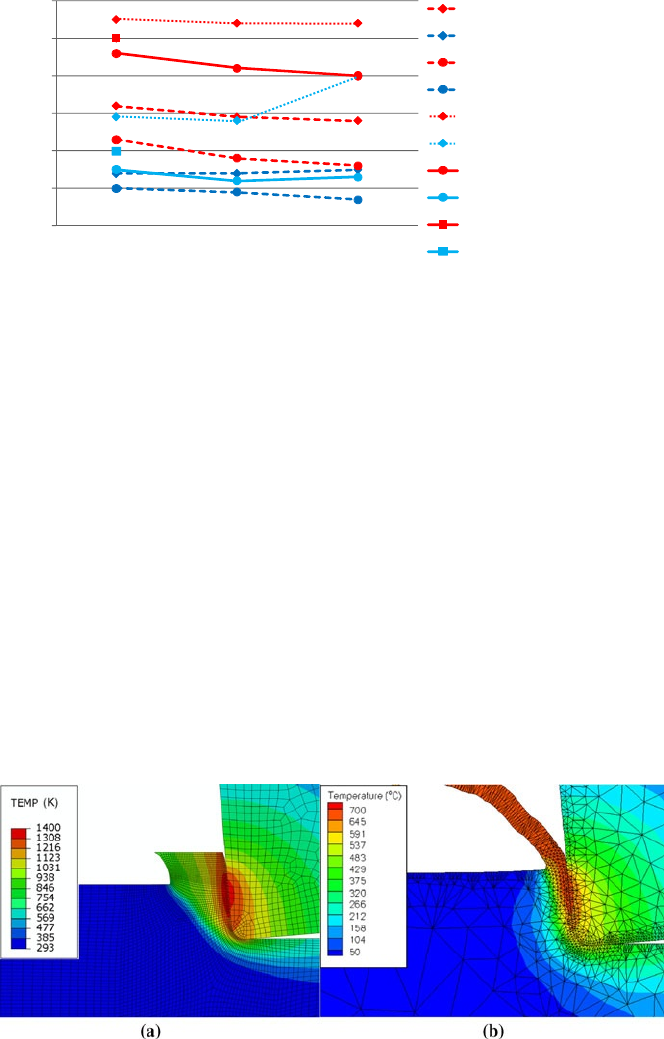
5 Finite-element Modeling and Simulation 153
Figure 5.4 shows the cutting and feed forces depending on the cutting speed,
the undeformed chip thickness (feed rate) and the cutting-edge finishing.
Comparing cutting forces, fairly different results have been obtained in the two
programs, with cutting forces around 90
N in Abaqus and 60
N in AdvantEdge.
The feed forces match better and vary from 60 to 50
N.
Comparing the results obtained with AdvantEdge it is observed that with the
chamfer finishing cutting and feed forces are higher than with a round edge fin-
ishing. For instance at the cutting speed of 120
m/min and feed rate of 0.15
mm
the cutting force increases from 82 to 94
N. As for the feed force, it increases
from 52 to 69
N.
As for the feed rate, it is also observed that moving the feed rate from 0.1 to
0.15
mm induces an increase in the cutting and feed forces in the same proportion.
For instance at the cutting speed of 120
m/min and with a round chamfer finishing
edge, the cutting force increases from 69 to 94
N and the feed force from 53 to 69
N.
The influence of the cutting speed seems to be more negligible with a slight de-
crease of both cutting and feed forces as the cutting speed increases.
Figure 5.5 shows the temperature fields for both radius-tooled models at
100
m min
–1
. A maximum temperature of 1350
K is achieved in the tool in
40
50
60
70
80
90
100
100 120 140
Cutting forces (N)
Cutting speed (m·min
-1
)
Fc chamfer 0.1mm feed
Ff chamfer 0.1mm feed
Fc radius 0.1mm feed
Ff radius 0.1mm feed
Fc chamfer 0.15mm fee
d
Ff chamfer 0.15mm feed
Fc radius 0.15mm feed
Ff radius 0.15mm feed
Fc Abaqus
Ff Abaqus
Figure 5.4 Cutting forces obtained in all the tests
Figure 5.5 Temperature fields in Abaqus (a), and AdvantEdge (b). Cutting speed of 100
m min
–1
,
feed rate of 0.1
mm, and cutting radius of 25
μm
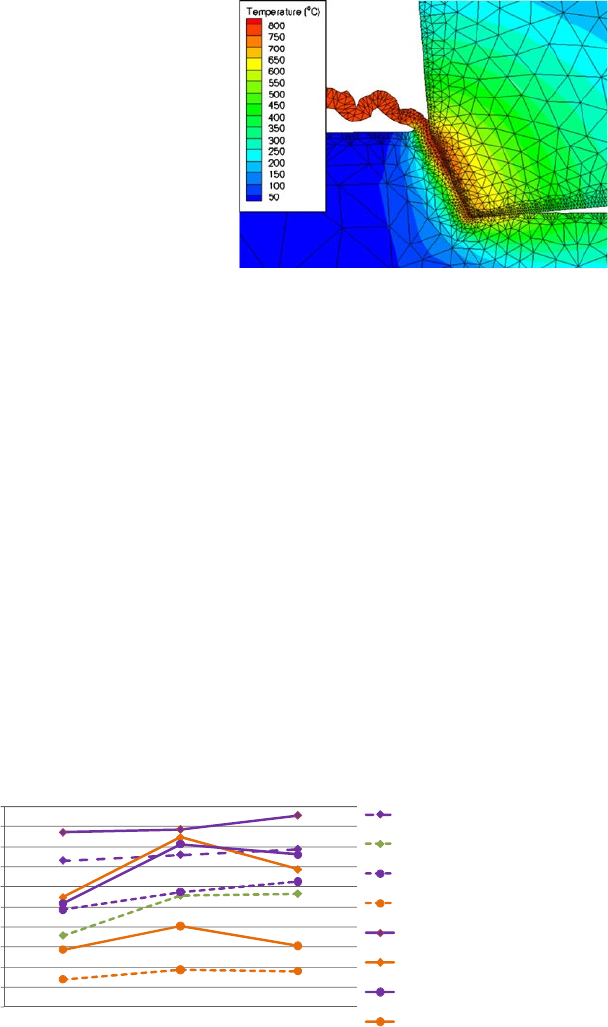
154 P.J. Arrazola
Abaqus, while the maximum temperature obtained in AdvantEdge is 958
K. These
differences can be expected as the input parameters are not the same, although it
was attempted to have similar ones.
In the case of the workpiece, Abaqus reaches 1150
K, while in AdvantEdge the
maximum temperature is 843
K.
Figure 5.6 shows the temperature fields for the hard-turning simulation in the tool
and workpiece for the chamfered model at 120
m min
–1
. A temperature of 1079
K is
achieved in the tool, while the maximum temperature in the workpiece reaches
978
K. Compared to the round-edge model (Figure 5.5 (b)), higher temperatures
have been obtained both in the tool and workpiece. It is also observed that higher
thermal-affected zones are obtained when employing chamfered cutting edges.
Figure 5.7 shows the temperature trends in the tool and workpiece depending
on the cutting speed, cutting-edge geometry, and feed. As the tool and chip tem-
peratures are very similar, only tool values are shown. In general it is observed
that as the cutting speed increases there is a slight increase in temperature values.
In all the cases the maximum temperature is reached in the tool. Comparing
the round edge with the chamfered edge, it is observed that higher values are
obtained for the latter (as mentioned before). For the chamfered tool, a maximum
of 1079
K is attained in the tool and 978
K in the workpiece. Using round cutting
edges seems to decrease the maximum temperature, achieving 987
K in the tool
Figure 5.6 AdvantEdge: cutting
speed of 100
m min
–1
, feed rate of
0.1
mm, and chamfered cutting edge
700
750
800
850
900
950
1000
1050
1100
1150
1200
100 120 140
Temp era tu re (K)
Cutting speed (m·min
-1
)
Tool chamfer 0.1 mm feed
Workpiece chamfer 0.1 mm feed
Tool radius 0.1 mm feed
Workpiece radius 0.1 mm feed
Tool chamfer 0.15 mm feed
Workpiece chamfer 0.15 mm fee
d
Tool radius 0.15 mm feed
Workpiece radius 0.15 mm feed
Figure 5.7 Cutting speed, feed and cutting-edge finishing influence in tool temperatures
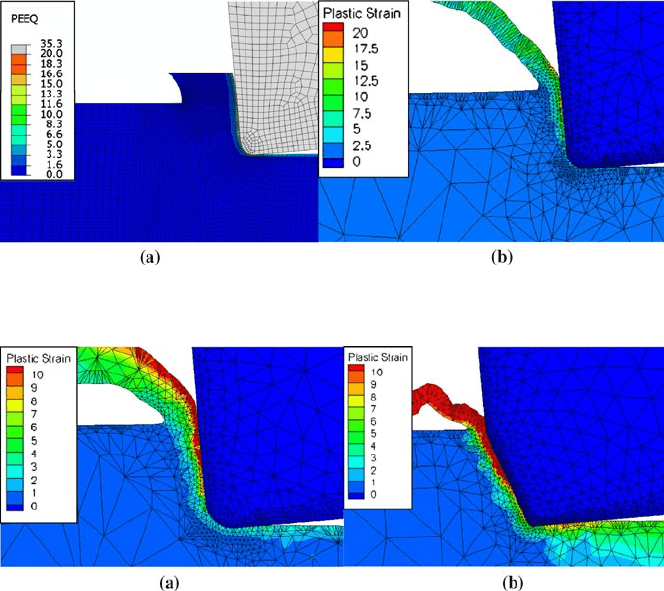
5 Finite-element Modeling and Simulation 155
and, remarkably, only 793
K in the part – almost 200
K below that in the cham-
fered-edge model. Thus from the thermal point of view, round cutting edges
would seem to withstand hard machining better.
As for the feed rate, when comparing values for a feed rate of 0.1
mm and
0.15
mm differences of roughly 100
K are found (lower in the former).
Moving the cutting speed from 100 to 140
m min
–1
causes a slight rise in the
tool temperature, around 50
K.
Nevertheless, for the 0.15-mm-feed models a sin-
gular effect has been observed: the workpiece temperatures suffer a high increase
at the cutting speed of 120
m min
–1
.
Figure 5.8 shows the plastic-strain distribution in Abaqus and AdvantEdge. Ex-
tremely high values, close to 20, are found in both models. It can be seen in Fig-
ure 5.9 that similar maximum plastic-strain values are found in the chamfered-
edge and round-edge models (close to 9–10). The plastically affected zone in the
radius-tooled model is 20
μm in depth, while in the chamfered model this zone
extends to about 600
μm. These higher values in the workpiece plastically affected
zone can be the cause of the temperature differences in the machined surface and
may affect the residual stresses.
Figure 5.8 Plastic strain in Abaqus (a) and AdvantEdge (b). Cutting speed of 100
m min
–1
, feed
rate of 0.1
mm and cutting radius of 25
μm
Figure 5.9 Plastic equivalent deformation plots of radius model (a) and chamfered model (b) in
AdvantEdge at 100 m min
–1
and 0.1
mm feed
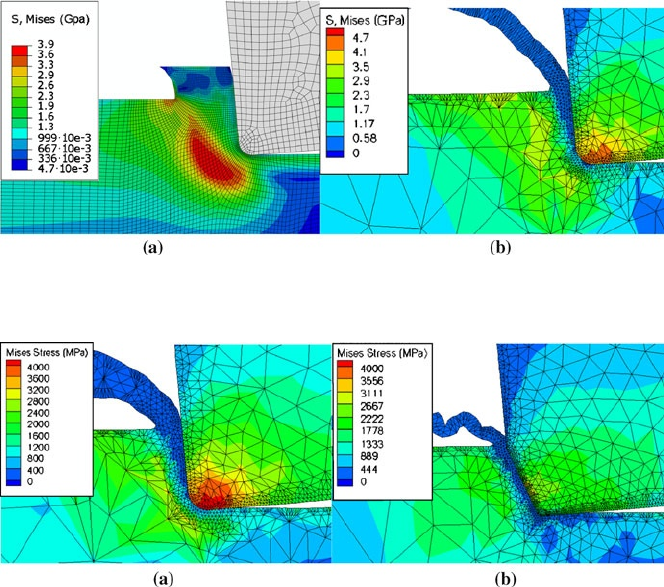
156 P.J. Arrazola
Figure 5.10 shows the stress distribution in Abaqus and AdvantEdge. Similar
stress values are obtained in the case of Abaqus compared with AdvantEdge for
the workpiece material (3.9
GPa).
Nevertheless, regarding the stress fields obtained, in Figure 5.11 it is clearly
visible how higher maximum stresses are obtained in the round-finished tool
compared with the chamfered tool (4
GPa for round cutting edge and 2.5
GPa
for chamfered tool). This means that for the same cutting conditions lower
stresses will be found in the chamfered tool, and longer tool life would be ex-
pected. This trend is also found in the rest of the tests carried out. Considering
the stresses it seems that chamfered-insert tools will endure better than round
cutting edges in hard turning. This conclusion is opposite to the one obtained
from temperature results.
Figure 5.12 shows the serrated chip obtained when machining at the cutting
speed of 100
m min
–1
, feed rate of 0.1
mm and cutting radius of 25
μm with Ad-
vantEdge. To obtain this serrated chip with the Abaqus/Explicit model, smaller
element dimensions should be employed (4–8 times smaller) [57]. This phe-
nomenon appears in all of the calculations performed for the radius tool for
Figure 5.10 Mises equivalent stress fields in Abaqus (a) and AdvantEdge (b) at 100
m min
–1
and 0.1
mm feed
Figure 5.11 Mises equivalent stress plots of radius model (a) and chamfered model (b) in
AdvantEdge at 100
m min
–1
and 0.1
mm feed
